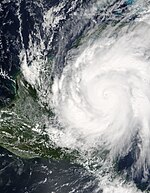Climate of Florida
[1] There is a defined rainy season from May through October when air-mass thundershowers that build in the heat of the day drop heavy but brief summer rainfall.
Fronts from mid-latitude storms north of Florida occasionally pass through northern and central parts of the state which bring light and brief winter rainfall.
[3] From a tropical cyclone, the lowest pressure measured was 26.35 inches/892 hPa in the Florida Keys during the Labor Day Hurricane of 1935.
The peak wind gust during the 1930 through 1997 period was 115 miles per hour at Miami International Airport during Hurricane Andrew.
Its presence negatively impacts air quality across the Southeastern United States during the summer, by adding to the count of airborne particulates.
[8] Dust events are possibly linked to a decline in the health of coral reefs across the Caribbean and Florida, primarily since the 1970s.
Occasional strong cold fronts move southward down the peninsula with freezing or near-freezing temperatures on a few nights into inland areas of central Florida every few years.
USDA Zone 9B, with average annual lows between 25°F and 30°F, is found in interior Central Florida, continuing north towards Fernandina Beach.
[15] Despite being the mildest on average, the winter climate was a crucial contributing factor of the Challenger disaster on January 28, 1986, in which overnight temperatures at Titusville, adjacent to the Kennedy Space Center, had dropped as low as 24°F[16] and were still below freezing at 28.0°F to 28.9°F on launch day.
[18] Like the remainder of the Southeastern United States, Florida has a winter maximum in dense fog conditions.
Unlike the remainder of the region, the maximum in Florida contains roughly half of the annual occurrences per year, on average.
The annual number of heavy fog days (with visibility of .25 miles (0.40 km) or less) has ranged from 50 in Tallahassee, to 1 in Key West, the least foggy region in the state.
In northern Florida, there is a weak winter secondary maximum while statewide the driest months of the year are during the spring.
[12] Due to the lack of the secondary maximum across the peninsula, a distinct dry season is seen in the averages from winter through spring.
[22] Heavy rainfall events have fallen due to stalled fronts near the state as well, and occur during the March through May and October through November timeframe.
[31] The state record for snowfall is 5 inches (13 cm), set in northern Florida during January 1800, though some debate exists about the accuracy.
Some places report in excess of 90 thunderstorm days per year, making Florida one of the most thundery regions outside of the tropics.
The most likely targets of lightning strikes are construction workers and others who work outside, though 12 percent of the cases occurred indoors to people using electronic devices.
These seabreezes from the Gulf and Atlantic often collide over the peninsula sometimes producing severe weather with small hail and winds.
Strong tornadoes do occasionally form in Florida, usually in conjunction with a cold frontal passage in the winter or spring.
A total of 42 people died in February 1998 from the deadliest such tornado outbreak in Central Florida, which occurred during the nighttime hours.
Portions of the coastline have the lowest return period, or the frequency at which a certain intensity or category of hurricane can be expected within 86 miles (138 km) of a given location, in the country.
Northern Florida is more susceptible to severe weather; below normal temperatures, increased number of low pressure systems in the Gulf of Mexico during the winter, and "almost always" reduces the frequency of storms and hurricanes.
[45] La Niña has the following effects: often dry conditions prevail in late fall, winter and early spring, increased risk of wildfires in spring and summer months, the temperatures average slightly above normal, and the chance of hurricane activity increases substantially.
A narrow eastern part of the state including Orlando and Jacksonville receives between 2,400 and 2,800 hours of sunshine annually.







